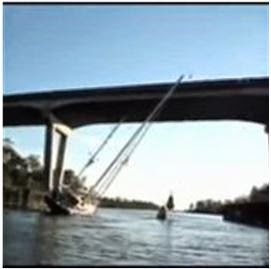I remembered to start today's class with Act II of Boat on the River. We had come up with the question yesterday - at what angle does the boat need to be to make it under the bridge safely?
So, Act II -what information do we need? It took no time for my students to tell me that we needed the length of the mast and the height of the bridge. This is what they got:
Hmmm, not actual measurements. Can we use these? Someone said yes. I asked why. Then the magical words "scale factor" were said. Such a happy moment! We went over the idea that because we are calculating a ratio in trig, we don't need to find the actual values for the length of the mast and the height of the bridge. They then set about finding the angle in question and did a good job. It is great to see how well they can apply "SOH-CAH-TOA" because they are so solid on the ratios. We then watched Act III of the video and talked about how the owner of this boat save him/herself a lot of time and money by doing a little research and a little trigonometry.
Next, we jumped into quadratics by looking at work did a while back. They found the zeros of four quadratic equations in factored form given the graphs and noticed a relationship.
We went over the vocabulary quickly (zero, vertex, y-intercept, axis of the curve...) and then they were paired up to do a little activity, inspired by Dan Meyer. Each student got a sheet that looked something like this:
which they folded in half. The goal was for each student to graph their partner's graph by asking only yes/no answer questions or questions that had a coordinate pair as the answer.
Most groups did a really good job. It was cool to hear the math talk going on and how they explained the concepts to each other. My goal was to ensure that they knew the vocabulary of quadratics and I believe that was accomplished. Here is what it looked like:
Next, still in pairs, they were each given one of the following scenarios:
Their job was to sketch the appropriate quadratic (most were height vs. time or height vs. horizontal distance). In order to do that they had to decide what information they needed and come up with a reasonable estimate for each piece of information. All that Estimation 180 is being put to use! Their handouts looked something like this:
I came up with this activity while covering someone else's class first period this morning so this is classic "just in time" work. But I really, really like this activity. My students looked at it and said "I don't know what to do.", but once I asked them a couple of questions they were off and running. They really needed to think about the situation they were working with to come up with a big picture of what was happening, and then think about what they needed to know to produce a good sketch. I think there is a lot of value in continuing this tomorrow.








No comments:
Post a Comment